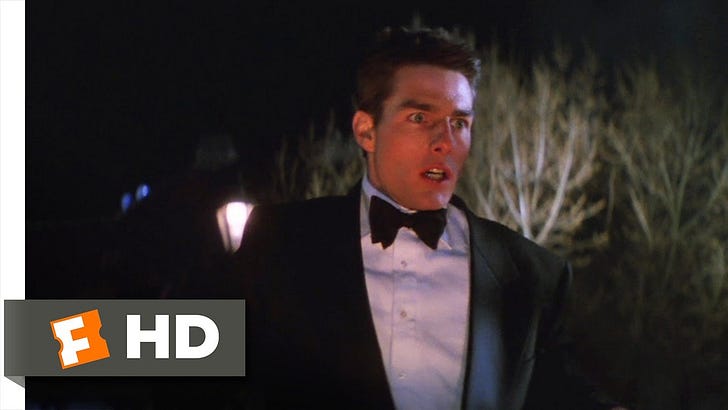Poe is Pulped: Mission Impossible
Brian De Palma works in extreme colours and violent contortions.
Grade: B-
The first Mission: Impossible film, directed by Brian De Palma in 1996, is pulpy and Gothic at the same time. De Palma is perhaps the only director who’s achieved this unique blend of 20th century pulp fiction with its POWS! and WHAMS!! and 19th century macabre tales ringing with wails and gushing blood. Don’t forget, he was inspired by Hitchcock and inspired Tarantino. You can see it in his best films (Carrie), his worst ones (Body Double) and his films that are enjoyable enough to watch painlessly but not good enough to recommend, re-visit or rave about. Mission: Impossible lands in the third category.
It stars Tom Cruise as American spy Ethan Hunt who starts the film infiltrating a glitzy gala at the US embassy in Prague to stop a mole from stealing the list of every undercover agent in Easter Europe. If that list is stolen, Jim Phelps (Jon Voight), Hunt’s mentor and mission leader warns him, those agents will “be executed.” Be executed. Phelps’ multi-syllabic diction may remind you of the comic book heroes and villains who use big words to sound even more impressive. The extreme action of the incidents that bookend the film are also straight out of a comic book to thrill any excited spy fan. Hunt ends the film clinging to the top of a bullet train as he’s chased by a helicopter that follows the train into the tunnel under the English Channel. His ability (or shit luck depending on your POV) to jump from one supercharged spy scenario to the next may very well put James Bond to shame, as may some of his gadgets: glasses with cameras in them, watches containing TV screens (remembering MI was made in the 90s before smart watches) and exploding chewing gum. There’s a childish gimmickry about Hunt and his missions that doesn’t permit much concern about plausibility or looking ridiculous.
Yet alongside this kid’s playfulness is a very Gothic visual excess and sense of discordance. De Palma works in extreme colours and violent contortions. Everything he touches becomes saturated as the colours of the characters’ clothes, weapons, surroundings and even their own skin and hair are pushed to their point of absolute concentration. Blacks in Hunt’s jacket and another agent’s knife are dark enough to be made from obsidian. The soft and creamy face of Ethan’s fellow agent and (maybe) lover Claire (Emmanuelle Beart) and her chestnut hair glow with a luminescence that makes her look like a lady from a Pre-Raphaelite painting. Ethan and Claire are never shown making love, and Claire is married to Jim. Ethan strokes her face once while she’s unconscious. When they banter with the rest of the team, including Jim, their eyes throw the playful sparks of lovers at each other. Claire later asks Ethan to “Come here” and takes his hand and hungrily kisses it but then De Palma fades to black. Are they lovers or do they just fancy each other? Are they cheating on Jim mentally or physically? This uncertainty only gives you a greater sense of epistemological precariousness as you watch the film. It’s a sense that there’s something amiss, something you don’t know, and that De Palma encourages with his constant use of shots from extreme angles, high or low, bent to one side or another, that make the film look almost all the time like there’s something out of whack disturbing the frame’s balance.
I’ve watched Mission: Impossible multiple times but I’ve never felt a strong desire to watch it again or to write about it. I don’t care very much about Ethan Hunt. Who is he, except a man who, like De Palma, has a fondness for at times absurdly extreme episodes of action and funny gadgets? Is he an existentially focused professional like Neil McCauley and Vincent Hanna in Heat? Does he want to get home like Dom Cobb in Inception, or to be free of the place the world tries to force him into like the Smokestack Twins in Sinners? Unlike Michael Mann, Christopher Nolan and Ryan Coogler, De Palma does not invest much if anything into his action sequences except for his outstanding imagination for physical action fantasy.
De Palma’s is an impressive imagination but like that of the pulp and penny dreadful writers he emulates it’s one limited to surface.



